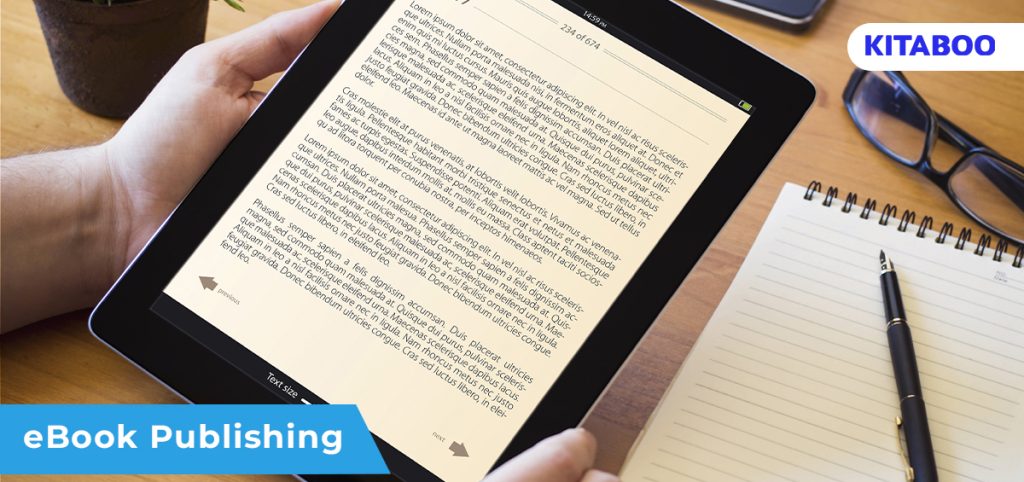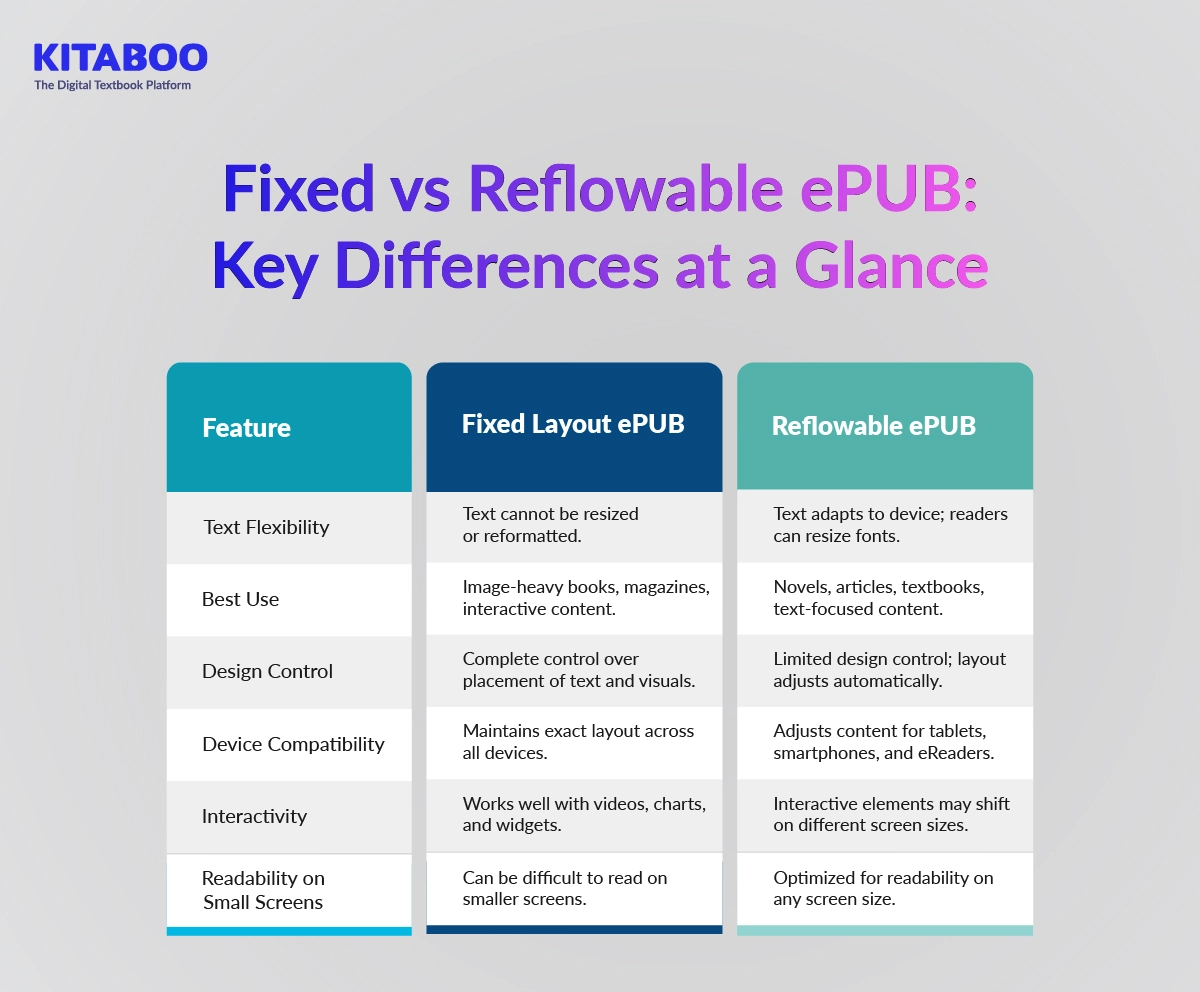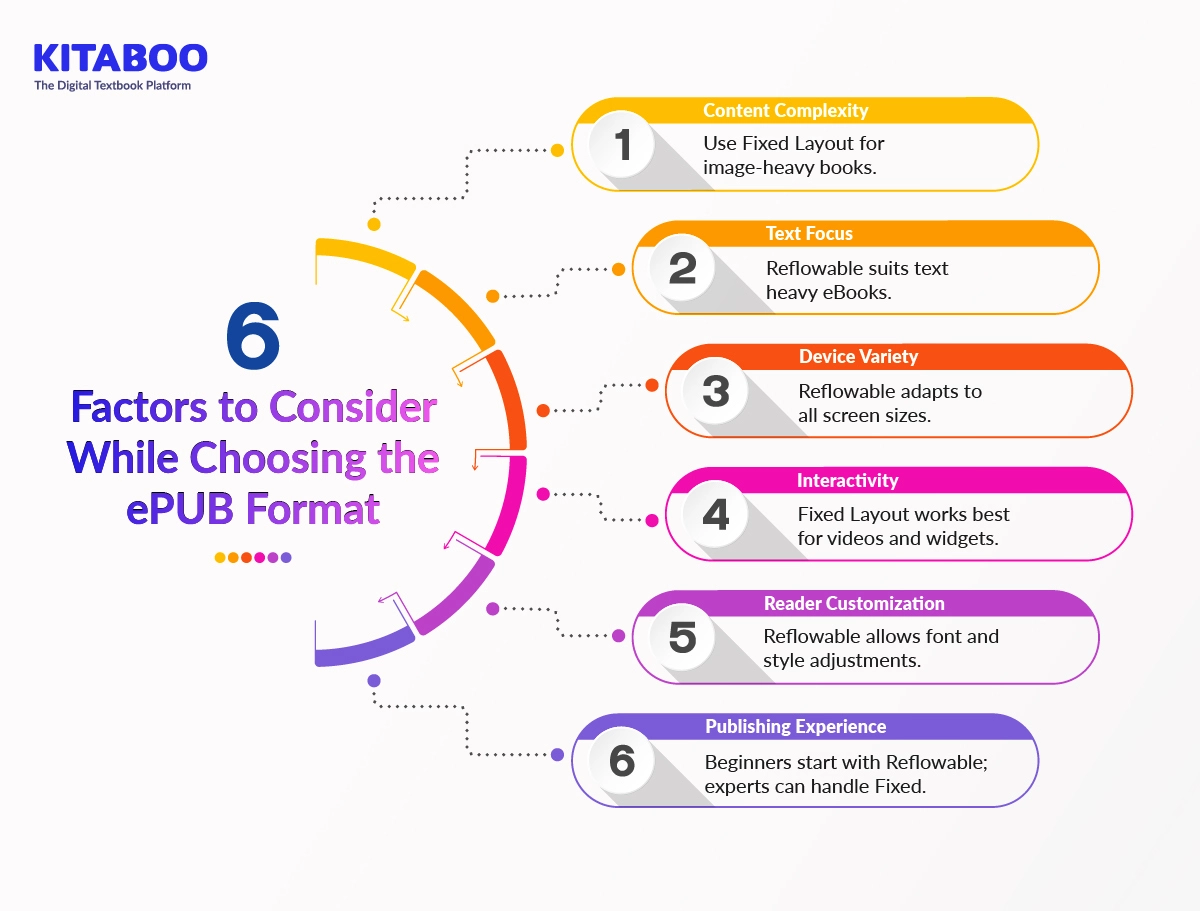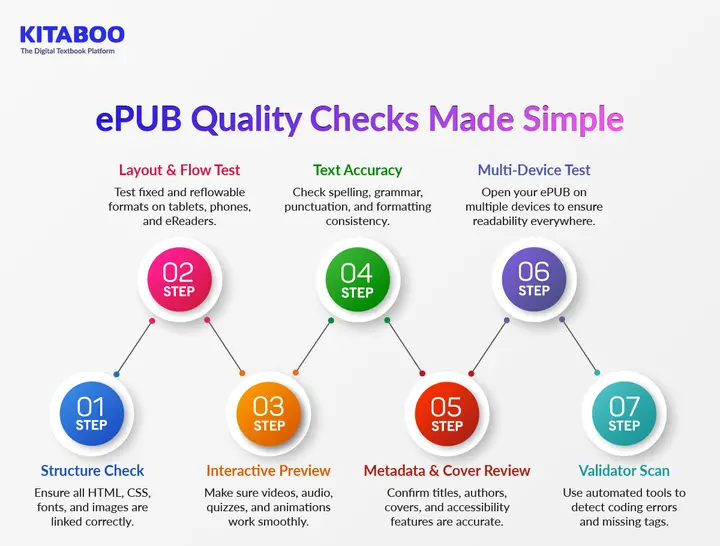
Simple Step-by-Step Guide to Creating an ePUB in 2025
Summarize this blog with your favorite AI:
Simple Step-by-Step Guide to Creating an ePUB in 2026 – TL;DR
Creating an ePUB can be simple when you follow a structured approach.
Whether you are learning how to create an ePUB, following an ePUB creation tutorial, or creating ePUBs for beginners, understanding layout formats and using the right software is essential.
Adding interactive elements and performing quality checks ensures your eBook is professional and reader-friendly.
These steps ensure your eBook is engaging, professional, and compatible across devices.
| Steps | Key Focus | Why It Matters |
|---|---|---|
| Choose Layout | Fixed vs Reflowable | Determines how content displays on different devices. |
| Select Software | KITABOO, InDesign, Sigil, etc. | Software choice affects interactivity and design flexibility. |
| Add Interactive Elements | Audio, video, quizzes, animations | Increases engagement and reader interest. |
| Proofread & Format | Text consistency, headings, page breaks | Ensures readability and professional appearance. |
| Verify Metadata & Cover | Title, author, language, cover image | Improves discoverability and presentation. |
| Device & Layout Testing | Multiple devices, screen sizes | Confirms compatibility and smooth reading experience. |
| Run ePUB Validator | Automated checks for errors | Avoids display issues and platform rejections. |
Creating eBooks has never been easier, thanks to modern digital publishing tools. If you’re new to the field, this guide to creating an ePUB will walk you through the entire process.
From understanding ePUB formats to adding interactive elements, this blog covers everything a beginner needs.
Whether you want to learn how to create an ePUB or follow an ePUB creation tutorial, this guide will help. It also supports creating ePUB for beginners to design professional, reader-friendly digital books.
Table of Contents
II. What’s the Difference Between Reflowable and Fixed Layout ePUB Formats?
III. Choosing the Right Format
IV. How to Create an ePUB using Top Tools Available?
V. How to Add Interactive Elements to ePUBs?
VI. Where Can You Sell an ePUB?
VII. Top Tips to Keep in Mind to Create a Balanced ePUB
VIII. How Do You Perform ePUB Quality Checks Before Export?
IX. Conclusion
X. FAQs
What is an ePUB?
Electronic Publication Format, or ePUB, is a term applied to many digital publications. eBooks are the most common term used for describing ePUBs.
The structure of this digital book is generally based on HTML and can be accessed through several digital devices such as laptops, tablets, computers, or dedicated eReader devices.
If you want to become an ePUB creator, it is necessary to know that ePUB can be made in two formats: fixed layout and reflowable layout.
What’s the Difference Between Reflowable and Fixed Layout ePUB Formats?
If you’re exploring how to create an ePUB, one of the first decisions you need to make is the layout format. The layout determines how your content appears on different devices and how readers interact with it.
Understanding the difference between fixed and reflowable formats is crucial for a successful eBook.
Fixed Layout ePUB
A fixed layout keeps all elements, including text, images, and graphics, exactly where you place them. This format is ideal for books with complex designs, such as illustrated textbooks, children’s books, or magazines.
The visual arrangement remains the same across devices, which ensures your creative design is preserved.
Advantages of Fixed Layout:
- Perfect for image-heavy or graphically complex eBooks.
- Preserves exact placement of text and visuals.
- Great for interactive elements like videos, charts, and widgets.
Limitations:
- Text cannot be resized by the reader.
- Less flexible on smaller screens, which may affect readability.
Reflowable ePUB
Reflowable ePUBs adapt to the reader’s device. Text, images, and tables adjust automatically. This ensures optimal readability on tablets, smartphones, and eReaders.
Users can modify font size, style, and line spacing. This format works best for novels, articles, and other text-focused content.
Advantages of Reflowable Layout:
- Flexible text that adapts to any screen size.
- Allows readers to customize font size, type, and background.
- Ideal for long-form text like novels and academic content.
Limitations:
- Design and layout control is limited.
- Complex images or multimedia may not align perfectly.
Choosing the Right Format
Selecting the appropriate format is a critical step in creating ePUB for beginners or following an ePUB creation tutorial.
Fixed layout is best for visually rich content that relies on precise design. Reflowable layout works well for text-heavy eBooks that need to be accessible across devices.
By understanding these formats, even beginners can confidently make an ePUB step-by-step. They must ensure the right balance between design, readability, and interactivity. This approach also serves as a comprehensive guide to creating an ePUB.
How to Create an ePUB using Top Tools Available?
When creating an ePUB, selecting the layout will be your first choice. You should choose software that can export ePUBs.
Online publishing is relatively new, and currently, there are no market leaders in this field. This is best for you as you will have several options, and by considering your budget and skills, you can easily choose an appropriate software that will fulfill your needs.
The following are some famous software you can use as an ePUB maker.
KITABOO
KITABOO is an easy-to-use ePUB creation platform. It provides several features that will allow you to make the best ePUBs.
This ePUB creation platform offers a refreshing UI, offline reading mode, book download feature, text highlighting, search text, annotation tools, social learning, and many more.
KITABOO is frequently used by top educational facilities, book retailers, non-profit businesses, societies, and associations.
Adobe Digital Publishing Solution
Adobe has developed this software to meet the needs of digital publishers. It is the best option for creating ePUB for beginners. It allows users to make and design complex layouts for digital devices without coding.
Adobe InDesign
This is eBook creators’ favorite choice. This software has several great features for eBook creators and has been created to design the best ePUB.
With this software, you can directly export the current designs to both fixed-layout and reflowable formats.
Adobe InDesign is a subscription-based product with several plans for schools, businesses, and individuals. This software can easily work with other Adobe tools, such as Illustrator and Photoshop, allowing you to easily shift the content between the programs.
Sigil
Sigil is the best option if you are on a low budget. Even if you don’t know exactly how to create an ePUB, It is free software that you can download this software and use right away.
You can download and use Sigil on Windows, Linux, and Mac. It is the best option to create conventional ePUBs with minimal interactive content.
BlueGriffon
BlueGriffon is another great option for creating ePUBs and is ideal if you are more inclined towards creating traditional text ePUBs. Unlike Sigil, it is subscription-based software that you can use on Mac, Linux, and Windows.
How to Add Interactive Elements to ePUBs?
Adding interactive additions such as animation and video content will be an additional touch that will make your ePUB interesting and attractive.
Adding interactive elements to educational eBooks will increase the interest of readers. There are several ways to add interactive content to your ePUB designs.
Once you have set up the basic ePUB layout, you can use software to add animations and interactive engagement elements to your book. Kitaboo is one of the ideal platforms for this purpose, as it has the best designs and interactive elements you can use in your ePUB.
Where Can You Sell an ePUB?
Once you have your ePUB ready, it is time for you to share it online. Several eBook publishing software will directly link you to an eBook store like Apple iBooks Author as it encourages the maker to upload the final product on sale.
One of people’s favorite digital publishing platforms is KITABOO. Whether you are a K12 publisher or higher education publisher, you can easily create attractive and interactive eBooks for customized learning that will meet the needs of all people.
With KITABOO, you can enhance student engagement by adding multimedia and interactive elements such as audio, video, images, widgets, assignments, and read-aloud.
Top Tips to Keep in Mind to Create a Balanced ePUB
- The text body should have the same size, font, and color.
- Do not add images behind the text body. Alternatively, you can use a light background to make it easier to read.
- Leave spaces between the visuals and texts.
- Maintain a similar style for the paragraphs. For eBooks, the most appropriate style is the Justified style. Avoid using short words such as “and.”
- Make sure to add page numbers. Fix a position to put the page numbers. You should use the same size, font, and color for the page numbers.
- Add a table of content if your eBook has more than 15 pages. It makes it easy for the readers to keep track of their progress.
- Once you have designed your ePUB, do not forget to proofread it. Even if the initial text is perfect, proofreading will help you find mistakes like missing letters and duplicate words.
How Do You Perform ePUB Quality Checks Before Export?
Before publishing your eBook, performing thorough quality checks ensures a seamless reading experience. Whether you are following a guide to creating an ePUB or exploring an ePUB creation tutorial, these checks are critical.
Using a structured guide to creating an ePUB or ePUB creation tutorial helps even beginners produce high-quality digital books with confidence.
Following these checks ensures your ePUB is reliable, visually consistent, and reader-friendly.
1. Validate File Structure
Confirm all HTML, CSS, fonts, and image files are correctly linked. Broken or missing files can cause display issues across devices. Proper file structure ensures your ePUB meets industry standards.
2. Check Reflow and Layout
Test both fixed and reflowable sections on multiple devices, including tablets, eReaders, and smartphones. Ensure text adapts properly, images are positioned correctly.
Also, ensure that the interactive content is displayed without distortion. This step is crucial in any ePUB creation tutorial.
3. Test Interactive Elements
Verify that videos, audio, animations, quizzes, and widgets work smoothly. Malfunctioning interactive content reduces engagement, so thorough testing is essential when creating ePUB for beginners.
4. Proofread Text Content
Review spelling, grammar, punctuation, and formatting consistency. Check headings, lists, and page breaks. Small errors can affect readability, especially for educational or professional eBooks.
5. Verify Metadata, Cover, and Accessibility
Ensure title, author, language, and publication date are accurate. Check cover images for resolution and alignment. Also, confirm accessibility features like alt text for images.
Metadata errors or missing accessibility features can affect discoverability and reader experience.
6. Test Device Compatibility
Open your ePUB on multiple devices and eReaders to check display, fonts, layout, and interactive elements. Device testing ensures your ePUB is readable and functional across platforms.
7. Run ePUB Validator
Use automated tools to detect coding errors, missing tags, and formatting issues. Validators confirm your ePUB complies with standards for popular eReaders and platforms, preventing rejections during distribution.
Conclusion
Creating an eBook is not as tough as it may look. With the right tools and software, you can create a compelling eBook that will be loved by all.
If you are not sure where you want to publish your ePUB, you can turn to KITABOO; it is a full-fledged eBook publishing platform that is quick and automated.
With Kitaboo, you can easily explore new opportunities and easily connect with your audience on their preferred devices. It helps you deliver the best digital content, which can be compatible with several devices.
Contact our expert team now and get started!
To know more, write to us at contact@kitaboo.com
Guide:
How to Create a DRM Protected eBook
FAQs
An ePUB is a digital book format compatible with multiple devices like tablets, eReaders, and computers.
You can create an ePUB using platforms like KITABOO, Adobe InDesign, Sigil, or BlueGriffon.
Use fixed layout for image-heavy books and reflowable layout for text-focused eBooks.
Yes, you can include videos, audio, animations, quizzes, and widgets for better engagement.
Validate files, test layouts on devices, proofread content, verify metadata, and run an ePUB validator.
Discover how a mobile-first training platform can help your organization.
KITABOO is a cloud-based platform to create, deliver & track mobile-first interactive training content.





![Top 5 Free Publishing Sites for Independent Publishing [2026]](https://kitaboo.com/wp-content/uploads/2025/09/Top-5-Free-Publishing-Sites-for-Independent-Publishing-2026-420x235.webp)
